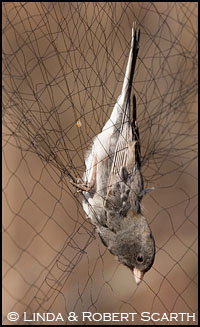introduction - galleries - technique - catalogue - notes - links - contact - blog - deep nature

Dark-eyed Junco
We humans have long been envious of the ?birds of the air?; wondering where they go and what they do when they disappear from our neighborhoods. Almost as soon as humans started keeping written records, they wrote about migration; often in poetic terms. The ancients recorded mass bird movements in the Bible, other stories and in their art. Greek and Roman naturalist/philosophers such as Aristotle (Greek) and Pliny the Elder (Roman) described some of their observations of birds moving through local and nearby lands.
Some people (including scientists of the day) believed that when birds disappeared in autumn, they moved into tree hollows or buried themselves in mud like frogs, to hibernate throughout the winter and revive again in the spring. Aristotle wrote of transmutation; the changing of one species to another from season to season. The birds one sees in winter were really the summer birds in different plumage. And then there were those, as late as the 18th century, who proposed that birds flew to the moon for the winter. As people came to understand that larger birds migrated, they still found it hard to accept that small ones did also. If they did migrate, it must be by riding on a larger bird?s back.
Just one hundred year?s after an essay promoting the moon migration idea, John James Audubon banded a brood of phoebe?s in Pennsylvania (the first recorded banding in the U.S.) to see if they returned. Two did. A metal band was used as early as 1595 on a Peregrine Falcon owned by King Henry IV. Dr. Paul Bartsch of the Smithsonian banded Black-crowned Night-herons in 1902. Jack Miner from Ontario, Canada started banding waterfowl in 1904 with bands sporting Bible verses. Then in 1914 the United States Biological Survey banded waterfowl for the first time. They wanted to see how far the sick ducks at the Bear River Marshes in Utah would travel before they died. In the last 100 years, some 58 million birds have been banded in North America.
Modern bird banders are a trained and licensed group of naturalists who band to learn more about the travels of migrating birds, and sometimes use their banding events to teach about birds. The Wickiup Outdoor Learning Center here in Linn County, Iowa sponsors several bird banding mornings each year. On a recent bright and sunny Saturday we were among the bird watchers and other curious folks who sat quietly as birds were taken from their carriers to be weighed, measured, banded or have old bands read.
Several volunteers carefully removed birds from the mist nets; placed them in carriers and brought them in for banding and inspection. One Downy Woodpecker had literally wrapped itself in the net like a cocoon and yelled and bit with vigor while being disentangled. It also had a lot to say when being measured and banded. The official bander talked about the data he was collecting while several volunteers recorded the information in a database on a laptop computer. The database was useful when a bird with a band was found. Weights were compared, the date of banding, and last capture date, were remarked upon.
The visitors got to see his tools and the array of bands. Though no hummingbirds were banded this winter?s day, a minute hummingbird band was passed around for inspection. The bander and others talked about how data is centralized, shared and used to understand more about migration and changes in bird populations.
There were several rows of mist nets at key points for capturing small birds. Two nets were strung parallel to the feeders near the center?s viewing windows. Noses were pressed against the glass to see the birds being removed. Another was along one side of a service road/trail back near the Osprey hacking tower. Woods and undergrowth on each side made the trail a good place for the net. The most common species caught were Downy and Hairy Woodpeckers, American Goldfinch, and Dark-eyed Juncos.
The highlight for most of the visitors, especially the children, was to assist in the release after banding. A volunteer with a bird carrier, followed like a Pied Piper by a flock of children, went to the outside deck. After showing everyone how to hold a tiny packet of feathers and feistiness that she retrieved from the carrier, she placed a bird in the child?s hands, and with her hands guiding, each child (and some adults) released a banded bird. The delight for child and watchers was a pleasure to see and feel. It was also a good day to watch people getting closer to nature (and to photograph a few birds).
? Linda & Robert Scarth, 2007.
First published in NatureScape News, 2 (2), 6, 2007.
